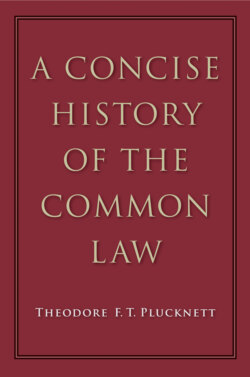Читать книгу A Concise History of the Common Law - Theodore F. T. Plucknett - Страница 127
На сайте Литреса книга снята с продажи.
THE RESULT OF THE CONQUEST
ОглавлениеIt is after the Norman Conquest that these institutions take a more definite form. The household continues to be the real political centre, and beside it, or perhaps within it, there develops a small council consisting of clerks and minor officials who are continually at hand for the transaction of daily business. The national assembly, on the other hand, begins to take a different complexion. It was one of the main features of feudalism that a lord could demand counsel from his tenants, and that those tenants were legally bound to attend their lord upon demand and to sit as a court in order to give him advice, to pass legal judgment upon fellow tenants, and to grant financial and moral support to the lord. The old national assembly therefore became a court with comparatively definite powers, and a well-defined obligation of attendance. For the time being it is true that its business was principally what we may describe as feudal. But in the eleventh and twelfth centuries feudal matters were of first-rate importance. Feudal custom regulated the position of the Crown with respect to the great nobles, and therefore supplied the place of a body of public law. The King’s Court, therefore, is not merely the Anglo-Saxon consultative assembly, but also a body entrusted with the power of applying such constitutional law as then existed.
It was also a peculiarity of feudalism that these matters of public law—the prerogative of the Crown, the rights and duties of the baronage, the means of extraordinary taxation and so on—were intimately connected with land. From this it resulted, first, that the King’s Court had to pay special attention to the law of land upon which these public rights and duties were based, and secondly, that these matters of essentially public law came to be regarded from the point of view of private property law. Political rights and privileges, the powers of particular officers and the like were treated as if they were land—or at least incorporeal hereditaments, which mediaeval law hardly distinguished from land. In this way there grew up the habit of regarding political and constitutional rights as sharing the specially sacred character of private property. As long as the common law controlled political thought, this attitude of mind persisted. No doubt there were grave disadvantages in the feudal view which treated governmental powers as private property—for one thing, they were apt to be regarded as private resources to be exploited to the limit; yet, on the other hand, the English constitution and the common law itself owed a good deal of their stability and continuity to the fact that all the sanctity which attached to private property could be invoked to protect the liberty of the subject. It is only when the modern theory of the State appears after the Reformation and the Renaissance that this point of view is theoretically attacked. This does not mean to say, of course, that the Crown never violated the rights of private liberty and property; as we shall see, more than once encroachments were made upon privileges which were the property rights of local magnates. Nevertheless, the theory was universally admitted, and in times of stress played an important rôle. As late as the fifteenth century many important questions of public law, such as the relations of Crown and Parliament, the theory of taxation, and so on, were discussed entirely from the point of view of a real property lawyer.1 All this, therefore, was the direct result of the feudal character of the King’s Court as it appears after the Conquest.
